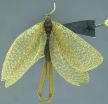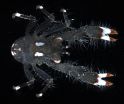(Press-News.org) Forcepflies are usually known as earwigflies, because the males have a large genital forceps that resembles the cerci of earwigs. A new species of forcepfly Meropeidae (Mecoptera) from Brazil was described, representing only the 3rd extant species described in this family and the 1st record of the family from the Neotropical region. The distribution and biogeography of the family are discussed and it is even proposed that Meropeidae originated before continental drift and then divided into two branches, northern and southern, with the breakup of the old supercontinent Pangea. The study was published in the open access journal ZooKeys.
Despite all previous collecting efforts in this area the species had never been recorded before. The specimen was collected in a private ranch near a forest fragment surrounded by farms in the Atlantic Forest biome, one of the most threatened in Brazil. It can be found in a variety of habitats, including woodland, Jarrah forest, and sand plain vegetation. What makes forcepflies special is the fact that little is known about their biology and the immature stages remain a mystery to scientists. The adults, who are nocturnal and seem to live on the ground, are also capable of stridulation, or the production of sound by rubbing certain body parts.
"The discovery of this new relict species is an important signal to reinforce the conservation of Brazilian Atlantic Forest biome. Certainly there are many more mecopterans species yet to be discovered in these forests", said the lead author Dr Renato Machado from the Texas A & M University, College Station, USA.
INFORMATION:
Original Source
Renato Jose Pires Machado, Ricardo Kawada, José Albertino Rafael (2013) New continental record and new species of Austromerope (Mecoptera, Meropeidae) from Brazil. ZooKeys 269: 1–10. doi: 10.3897/zookeys.269.4240.
Spectacular forcepfly species discovered for the first time in South America
2013-02-15
ELSE PRESS RELEASES FROM THIS DATE:
This is why it takes so long to get over tendon injuries
2013-02-15
The Achilles heel of the body – getting over damage to tendons can be a long and painful process. By combining the nuclear tests of the 1950s with tissue samples and modern technology, a research collaboration between the Aarhus University and University of Copenhagen now reveals why the healing process is so slow.
Many people are affected by injuries caused by straining the Achilles tendon and other tendons in the body. Danish athletes alone account for up to 200,000 injuries per year. This often leads to frustration over the poor treatment options available, and it can ...
Research uncovers a potential link between Parkinson's and visual problems
2013-02-15
The most common genetic cause of Parkinson's is not only responsible for the condition's distinctive movement problems but may also affect vision, according to new research by scientists at the University of York.
Parkinson's, the second most common form of neurodegenerative disease, principally affects people aged over 60. Its most common symptom is tremor and slowness of movement (bradykinesia) but some people with Parkinson's also experience changes in vision.
Now for the first time, researchers in the University's Department of Biology have established a link between ...
Playing quantum tricks with measurements
2013-02-15
This press release is available in German.
A team of physicists at the University of Innsbruck, Austria, performed an experiment that seems to contradict the foundations of quantum theory -- at first glance. The team led by Rainer Blatt reversed a quantum measurement in a prototype quantum information processor. The experiment is enabled by a technique that has been developed for quantum error correction in a future quantum computer.
Measurements on quantum systems have puzzled generations of physicists due to their counterintuitive properties. One of them is the fact ...
Can hospital readmission rates be trusted?
2013-02-15
MAYWOOD, Il. - When hospital patients have to be readmitted soon after discharge, hospitals look bad.
A high readmission rate also can result in reduced Medicare reimbursements. But a study of spine surgery patients has found that the standard method used to calculate readmission rates is a misleading indicator of hospital quality. Loyola University Medical Center neurosurgeon Beejal Amin, MD, and colleagues found that 25 percent of the readmissions of spine surgery patients were not due to true quality-of-care issues.
Results are reported in a featured article in the ...
The same genetic defect causes Pompe disease in both humans and dogs
2013-02-15
Pompe disease, a severe glycogen storage disease appearing in Lapphunds is caused by a genetic defect in acid α-glucosidase gene. The same genetic mutation also causes the equivalent disease in humans. Based on this finding, canine Pompe disease can now be diagnosed with a genetic test.
This research was completed at the Canine Genetics Research Group lead by professor Hannes Lohi in the University of Helsinki and Folkhälsan Research Center in Finland and will be published in PLOS ONE on February 14, 2013.
Human Pompe disease is caused by complete or partial deficiency ...
The discovery of a new genus of crustacean and 5 new species
2013-02-15
Experts from the Centre for Advanced Studies of Blanes and the University of Barcelona (UB) collected and studied different crustacean specimens during recent expeditions to Madagascar, New Caledonia, Vanuatu, the Philippines and French Polynesia.
Using morphological and molecular data they have discovered five new species of crustaceans in the waters of these regions. They are genetically different but morphologically very similar and they also found a new genus, named Triodonthea. The five new species documented in the study belong to the Lauriea genus of the Galatheidae ...
Force is the key to granular state-shifting
2013-02-15
Ever wonder why sand can both run through an hourglass like a liquid and be solid enough to support buildings? It's because granular materials – like sand or dirt – can change their behavior, or state. Researchers from North Carolina State University have found that the forces individual grains exert on one another are what most affect that transition.
Physicists have explored the changing behavior of granular materials by comparing it to what happens in thermodynamic systems. In a thermodynamic system, you can change the state of a material – like water – from a liquid ...
Chemists develop single molecule sieves to separate complex molecular mixtures
2013-02-15
Chemists at the University of Liverpool have created a new technique that could be used in industry to separate complex organic chemical mixtures.
Chemical feedstocks containing benzene are used extensively in industry to create modern materials and polymers. Their use relies heavily on distillation techniques which separate complex mixtures into more simple molecules used as building blocks to develop drugs, plastics and new materials. These distillation techniques can be expensive and involve large amounts of energy for hard-to-separate mixtures.
A team of researchers ...
Rutgers physicists test highly flexible organic semiconductors
2013-02-15
Organic semiconductors hold promise for making low-cost flexible electronics – conceivably video displays that bend like book pages or roll and unroll like posters, or wearable circuitry sewn into uniforms or athletic wear. Researchers have demonstrated the ability to "print" transistors made of organic crystals on flexible plastic sheets, using technology that resembles inkjet or gravure printing.
However, for the technology's potential to be realized, scientists have to show that these organic semiconductors will withstand the rugged handling they invite – they will ...
Extreme winters impact fish negatively
2013-02-15
Wcologists from Umeå University and the Norwegian University of Science and Technology in Trondheim have studied fish communities and fish habitat and reviewed the importance of winter conditions for fish in streams and rivers in cold regions. The findings are now being published in the journal BioScience.
It is well known that winter can be a stressful season for plants and animals in streams and rivers. It is reasonable to assume that more extreme weather conditions are the most taxing, but the ecological significance of this is poorly understood.
The research team, ...





